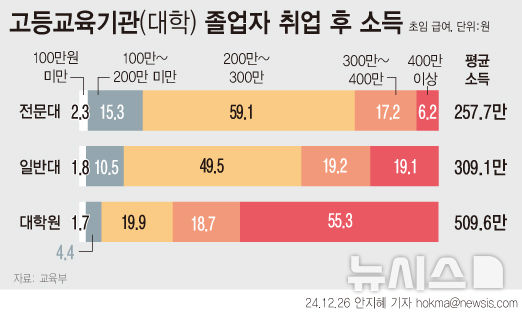한국인의 삶(5) 대학졸업자 취업률 : The Lives of Koreans (5) Employment Rate_2 (Topik graph)
한국인의 삶 (5) 대학졸업자 취업 편
The Lives of Koreans (5) Employment
안녕하세요! 오늘은 교육부와 한국교육개발원이 발표한 「2024년 고등교육기관 졸업자 취업통계」를 통해 한국의 대학 졸업자 취업률에 대해 알아보고, 유용한 한국어 어휘와 문법을 배워볼게요.
(Hello! Today, let's learn about the **employment rate** for Korean university graduates through the "2024 Graduate Employment Statistics for Higher Education Institutions" announced by the Ministry of Education and the Korean Educational Development Institute, and learn useful Korean vocabulary and grammar.)
**2022년 기준**, 한국의 고등교육기관 졸업자 취업률은 70.4%에 달하는 것으로 나타났습니다. 이는 전년 대비 0.2%p 증가한 수치로, 2017년 이후 꾸준한 상승세를 보이고 있어요. 특히 일반대학 졸업자의 취업률은 67.8%를 기록했습니다.
(As of **2022**, the **employment rate** for graduates of higher education institutions in Korea was **70.4%**. This is an increase of 0.2%p from the previous year, showing a continuous **upward trend** since 2017. In particular, the employment rate for graduates of general universities recorded 67.8%.)
전공별로는 의료/보건 계열이 84.9%로 가장 높은 취업률을 보였고, 공학 계열(75.1%), 교육 계열(63.2%)이 그 뒤를 이었습니다. 반면, 인문 계열(58.3%)과 사회 계열(61.2%)은 상대적으로 낮은 취업률을 기록했습니다. By major, the medical/health field showed the highest employment rate at 84.9%, followed by engineering (75.1%) and education (63.2%). On the other hand, the humanities (58.3%) and social sciences (61.2%) recorded relatively lower employment rates.
이러한 현상은 산업 구조의 변화와 고용 시장의 수요를 반영하고 있습니다. 최근에는 정보기술(IT), 보건·의료 분야의 인력 수요가 크게 늘고 있어 해당 전공자의 취업이 용이해지는 추세예요. 반면, 인문·사회 계열은 여전히 어려운 취업 환경에 직면해 있습니다.
(This phenomenon reflects changes in the industrial structure and the demands of the job market. Recently, the demand for personnel in information technology (IT) and health/medical fields has greatly increased, making it easier for graduates in those majors to find employment. In contrast, graduates in humanities and social sciences still face a difficult job environment.)

취업에 관한 더 깊은 이야기를 알고 싶다면, 다음 글도 함께 읽어보세요.
🔗입사 첫걸음: 마이크와 그레이스의 첫 만남 🔗직장생활 첫날, 대화 엿보기 🔗한국 직장생활 첫날오늘의 필수 어휘 3가지
Today's 3 Essential Vocabulary Words
1. 취업률 (Chi-eom-ryul)
의미: 일자리를 얻은 사람의 비율. Meaning: The percentage of people who have found a job. (Employment rate)
올해 대학 졸업자의 취업률이 역대 최고를 기록했어요. The employment rate for this year's university graduates hit an all-time high.
2. 상승하다 (Sang-seung-ha-da)
의미: 위로 오르거나 나은 상태로 나아가다. Meaning: To go up or advance to a better state. (To rise / to increase)
경기가 좋아지면서 주가가 상승하고 있습니다. Stock prices are increasing as the economy improves.
3. 전망하다 (Jeon-mang-ha-da)
의미: 앞으로의 일을 내다보고 예상하다. Meaning: To look ahead and predict future events. (To forecast / to predict)
전문가들은 내년 경제 성장을 긍정적으로 전망합니다. Experts forecast positive economic growth for next year.
취업과 관련된 더 많은 표현을 배우고 싶다면 아래 글을 참고하세요.
🔗한국어 실력 향상을 위한 열쇠!
연습 문제: 아래 빈칸에 알맞은 어휘를 넣어 문장을 완성하세요.
(Practice questions: Fill in the blanks with the correct vocabulary to complete the sentences.)
1. 새로운 정책 덕분에 청년 ____이 크게 개선되었다. (전망 / 취업률)
2. 이번 달 물가 상승률이 ____할 것으로 보인다. (상승 / 전망)
오늘의 유용한 문법 3가지
Today's 3 Useful Grammar Points
1. ~(으)ㄴ 것으로 나타나다 (~(eu)n geos-euro na-ta-na-da)
의미: 조사 결과나 통계 등을 통해 어떤 사실이 드러날 때 사용합니다. Meaning: Used when a fact is revealed through survey results or statistics. (It appears that / It is shown that)
고등교육기관 졸업자의 취업률이 상승한 것으로 나타났다. It was **shown that** the **employment rate** for graduates of higher education institutions **increased**.
2. ~에 달하다 (~e dal-ha-da)
의미: 어떤 수치나 정도에 도달했음을 나타냅니다. Meaning: Indicates that a certain number or degree has been reached. (To reach / to amount to)
수출액이 1억 달러에 달했습니다. The export amount has **reached** 100 million dollars.
3. ~에 비해 (~e bi-hae)
의미: 두 대상을 비교할 때 사용합니다. Meaning: Used when comparing two subjects. (Compared to / In contrast to)
인문 계열은 공학 계열에 비해 취업률이 낮습니다. The humanities major has a lower employment rate **compared to** the engineering major.
이 외에도 한국어 문법에 대해 더 알고 싶다면 아래 글을 읽어보세요.
🔗한국인도 헷갈리는 문법 5가지
연습 문제: 아래 문장을 완성하기 위해 알맞은 문법 표현을 넣어보세요.
(Practice questions: Insert the correct grammar expression to complete the sentences below.)
1. 이번 보고서에 따르면 여성의 사회 활동이 증가한 _____ **나타났다**. (것으로 / 대해)
2. 그는 다른 사람____ 일을 더 잘한다. (에 비해 / 에 따라)





